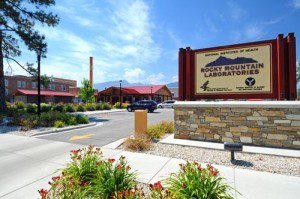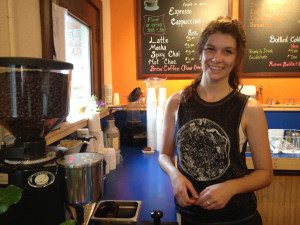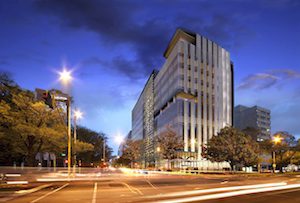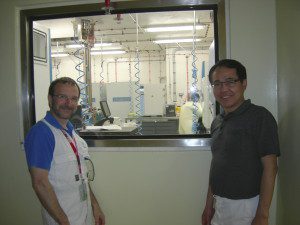Experiments with the most dangerous human viruses, such as Ebola virus and Lassa virus, are carried out in biosafety level 4 (BSL-4) laboratories. Since visiting the National Infectious Diseases Laboratory BSL-4 and releasing the documentary video Threading the NEIDL, I was given the opportunity to tour three BSL-4 laboratories in the United States and Australia. My impressions of each facility might be of interest to readers of this blog.


Rocky Mountain Laboratory (RML) is located in the small and sleepy town of Hamilton, Montana (population 4,508), in the Bitterroot Vally two hours drive from Missoula and its airport. RML is the answer to those who feel that BSL4 laboratories should not be located in large cities. The downside is that it is more difficult to accommodate two careers in such a small town. The laboratory began as a shack in 1928 to study Rocky Mountain fever, and subsequently expanded to today’s size.
RML is made up of numerous independent buildings in which research on viruses, fungi, and bacteria is conducted under BSL-2 conditions. One of the larger buildings houses a BSL-3 and a BSL-4 laboratory. I was invited to visit RML to present a seminar and was offered the opportunity to tour the BSL-4. In contrast to the NEIDL, the RML BSL-4 is a functioning laboratory and therefore it was not possible for me to enter the facility.
RML is surrounded by a high black metal fence reminiscent of the fence at NEIDL. My host drove to the front entrance and parked on the street. The laboratory is in a residential neighborhood, nestled among one and two story homes. We walked through the front gate and proceeded through a security cottage which is manned by an armed guard. I walked through an airport-style metal detector and my suitcase containing a portable TWiV studio was passed on a conveyor belt through an imager. I had already received security clearance to enter the facility and upon showing the guard my drivers license, I was signed in and provided with an identification card. I was also asked if I had any guns, weapons, or explosives.
After leaving the guard house it is possible to walk freely to and from the various laboratory buildings, although entry to any of them requires proper electronic identification. The BSL-4 laboratory is in a separate building and entry requires passing through another security check point with armed guard, metal detector, and more questions about guns, weapons, or explosives. After this procedure I received a second identification card.
The BSL-4 laboratory is contained within a larger building that also houses BSL-3 and BSL-2 laboratories. A large multistory atrium in the building interior separates the office and BSL-2 space from the BSL-4 and BSL-3 laboratories. The RML BSL-4 is very much like the NEIDL in that it is a concrete box that sits within the outer building. I entered BSL-4 perimeter space with a guide, who used his ID to enter a corridor which surrounds the concrete box, much like the NEIDL (a separate iris scan is needed to pass through the guard house at the entrance to the NEIDL grounds). Entrance to this corridor did not require an iris scan as in the NEIDL; however entry into the BSL-4 laboratory does require an iris scan. On the wall near the entrance was a LCD panel showing the air pressure in each of the BSL-4 rooms. Negative pressure is maintained to ensure that air enters but does not leave each room. As in the NEIDL, individual labs within the BSL-4 may be activated or deactivated as needed.
Both the BSL-4 cube and the corridor surrounding it have windows, so it is possible for workers in the BSL-4 to look across the atrium at the BSL-2 laboratories, and vice versa. I did not visit the BSL-3 lab, which was a smaller facility at one end of the BSL-4.
The first BSL-4 room that we passed was occupied by two workers. They wore sealed suits supplied with air through coiled hoses dropped at intervals from the ceiling, the same arrangement I found at the NEIDL. The suits at RML are different: the head portion is completely clear, providing what should be excellent peripheral vision. The NEIDL suits in contrast have a clear portion only on the front. While at the NEIDL high slip-on boots are worn over the suit, in the RML BSL-4 the workers wore Crocs.
Both workers in the BSL-4 recognized me and waved. One is a postdoctoral scientist in the laboratory of Elke Muhlberger; she is working at RML because the NEIDL is not yet operational. The other person picked up a cellphone and dialed my guide to tell me that I do a ‘great podcast’. I suppose this cell phone always stays in the facility and is used for outside communication. The worker was able to use the phone by holding it next to his suit headpiece. My guide told me that this was possible because the suits are quiet. Later I was told that a variety of devices are employed for communication within the BSL-4 lab itself, including headsets, landlines and cell phones. Learning how to use these devices is obviously crucial for proper emergency response and is a critical part of the training that everyone going into the lab must undergo.
The workers also wore wireless headsets with microphones for communicating with each other. This type of communication was being planned for the NEID but was not yet implemented during my visit. The NEIDL now has a fully functional in-suit communication system. It permits persons in the BSL-4 suites to communicate with each other as well as communicate with persons outside of the BSL-4 labs. Persons working in the laboratory always have someone outside the labs (but within the building) whom they communicate with while working in the BSL-4 spaces.
Also on the perimeter of the BSL-4 is the clothing room, where those heading for the BSL-4 select surgical scrubs, socks, and underwear. I was provided with a souvenir: a pair of disposable underwear. No personal clothing can be worn into the BSL-4. In the NEIDL I was allowed to wear my underwear only because I was on a tour; normally no personal clothing may be worn into the facility.
Entry into the RML BSL-4 is similar to that of the NEIDL: workers enter a locker room, change from street clothes to scrubs, and then pass into a second room where they don the sealed suits. They then pass through an airlock into the BSL-4. The outer door is opened by pushing a button on the door which releases the gaskets only if the second door is sealed. After entering the lock the door seals, and then a second sealed door is opened to enter the BSL-4. The same procedure is used to exit the lab except that a chemical shower is taken on the way out.
Like the NEIDL, the RML BSL-4 can support experiments with animals. Through one window I could see a technician weighing mice. The results

Overall the RML BLS-4 is very similar to the NEIDL. It exists to allow the safe conduct of experiments on the most dangerous human pathogens in cells and in animals. I did not request permission to photograph the RML. We were allowed to film ‘Threading the NEIDL’ to help demystify this type of laboratory, but the film was reviewed by their security team to ensure that nothing was filmed that could compromise security.
If you are in Hamilton, I strongly suggest you have coffee at Big Creek Coffee Roasters. The young lady at right made me one of the best cups of coffee I have ever had.


The Doherty Institute is a new multistory research facility built on the campus of the University of Melbourne, not far from the city center. It combines university research laboratories with diagnostic and WHO reference laboratories. The building contains a BSL-3 and BSL-4 laboratory. I entered the front door and passed by a security guard who was not armed and did not question my entrance. There were security gates by the elevators but they were not activated. I was told that the building security level is currently being negotiated between the university, who wants public access to the building, and the other laboratories who would like restricted accesss.
Any visitor to the Doherty can take the elevator to any floor, but access to the laboratories is restricted to individuals with ID cards that open locked doors. The exception is the fourth floor which has the cafeteria which is not locked. My host brought me to an upper floor where a guide showed us the BSL-4 laboratory. Although the BSL-4 is not operational I could not enter or take photographs because I had not requested proper permission.
The Doherty BSL-4 is quite different from those at RML and the NEIDL. It consists of one room where clinical specimens from suspected cases of hemorrhagic fever within Australia will be brought in and studied to determine if they contain any of the known hemorrhagic fever viruses. No research will be done in this BSL-4.
The Doherty BSL-4 is not housed in a concrete box. The facility is a separate entity within the outer building but it is built of panels of what appeared to be white metal with an insulated core. These are fitted together to make an airtight cube. The entire BSL-4 ‘box’ fits on one floor of the institute, with a narrow hallway between it and the outer walls of the building. There is a mechanical space of about four feet tall between the top of the BSL-4 box and the ceiling.
Entry into this BSL-4 takes place through airlocks similar to those in the RML and NEIDL facilities, and exit is through a chemical shower. The suits used in the facility resemble those in RML with completely clear head covers. We observed the BSL-4 from a command room which abuts the laboratory and has a clear view through large panes of glass. I was told that standard procedure will be that two workers must always be in the facility, and there must also be someone in the command center observing the workers. Communication between workers in the BSL-4, and also with the command center, is via headsets within the helmet. Video observation is part of the operating procedure in RML and NEIDL. These BSL-4 laboratories have numerous cameras which permit live viewing of the activities in the laboratories, and permit review at a later time.
The Doherty BSL-4 is the smallest and least flexible of those I visited. Its small size is consistent with its primary function, to diagnose viral hemorrhagic fevers. However it is not clear to me why clinical specimens could not be sent to the far more capable AAHL (below).


The AAHL is the oldest and largest biosafety laboratory that I have visited. It is operated by the Commonwealth Scientific and Industrial Research Organisation (CSIRO). It was opened in 1985 after a long construction period, and its original purpose was to house research on animal pathogens. Therefore the emphasis was on preventing animal pathogens from leaving the facility. Later it was expanded to include work on human pathogens and the BSL-4 capability was added. The impetus for the expansion was the discovery of Hendra virus in Australia in 1994.
The AAHL is in the city of Geelong, about an hour drive south of Melbourne. My host picked me up at my Melbourne hotel and drove south though a heavily industrialized area. However Geelong is a very pleasant coastal town and the AAHL is located in a bucolic setting near the sea. We drove up to the front gate which my host opened with an ID card. There is a guard shack at the entry gate but my host told me that the guard was removed some time ago as it was deemed unnecessary. The laboratory is a huge concrete building several stories high, dominated by a tall water tower that from the distance resembles a cross. My host opened the front door of the building with his ID card. I signed in at the front desk but there were no metal detectors or armed guards.
When I asked my host if I could take photographs he said of course, anything that I liked. He said only in the US do BSL-4 facilities worry about bioterrorism.
Before entering the laboratory I was required to take a brief training session. I watched a 10 minute video which detailed entry and exit procedures, and then took a 15 question quiz. I am sure I got all the answers right. Then my host and I entered the facility.
A large command center stands at the entrance of the facility. There a single individual monitors, on large displays, the status of each room and who has passed from section to section based on swiping of IDs on wall mounted sensors. I placed my valuables in a safe, and then we swiped our cards to unlock a revolving door and moved into the secure area.
The first step was to change our clothing. We reached a room lined with doors behind which were small locker rooms. I had been assigned to room 16, locker 16B. We had been instructed to knock first to be sure that no one else was in the room. Inside I found a narrow room with 10 small lockers. I removed all of my clothes, including my ID, and placed them in the locker. The only item I was allowed to bring in was my glasses.
At one end of the room was a metal door sealed with a gasket. To release the gasket I pushed a large, black rubber switch on the wall. In a few seconds the heavy metal door could be pushed open. As the door swung shut after me the gasket automatically sealed. Then I pressed another switch to open the second door and passed into a second locker room. Here I found locker #16B filled with clothing that had been selected according to my measurements, which I had sent several weeks earlier. I donned underpants, a blue short sleeved shirt, white overalls, socks, sneakers, eye guard, and another ID card. Outside of this room I met my host who then lead me around the laboratory.
My first impression was the imposing size of the facility: the ceilings are very high and the hallways are over 10 feet wide. My host told me that the hallways were made large by the original planners because they realized that workers would be spending a lot of time in the facility and did not want them to feel claustrophobic.
The walls of this facility are very thick concrete. To pass wiring through the walls, it was necessary to embed pipes in the concrete. These are visible at multiple locations and the wires going in and out of them are secured to the concrete surface. My host was excited to point out that the original planners had great foresight and installed numerous such conduits, not all of which are yet being used.
The AAHL is a multi-story facility divided roughly into three parts. On one side of building is a laboratory for large animals such as horses or cows, which can be configured as BSL3 or BSL4 space as needed. I did not see this part of the laboratory as the lights were off and nothing was visible through the windows.
The middle building section contains BSL3 and BSL4 laboratories which also can be configured as needed. The BSL4 space was like that in RML and the NEIDL – a concrete block within the building, with windows cut in the walls. I saw two scientists working in one of the laboratories. Here during working hours it is not necessary to have two workers in a BSL4, as long as there is an observer on the outside. After working hours and on weekends the two worker rule is in effect.
Procedures for entering and exiting the BSL4 are similar to those in RML and NEIDL, with airlocks and chemical showers. The AAHL BSL4 is used for research on all of the most deadly human viruses, both in cell culture and in animals. The BSL4 can also conduct work on smaller animals, such as mice and ferrets. One of the floors of the AAHL houses 25,000 mice.
We also visited the mechanical space in the basement. One floor consisted largely of HEPA filters – over 1,000 of them are needed to service the laboratory. Another floor contained the ‘cook tanks’, where liquid waste from sinks and showers is autoclaved. I saw over a dozen tanks, far more than the three at the NEIDL (the 3 NEIDL cook tanks are each over 5600 liters in size, which permits the facility to have one in use (filling with liquid waste) while another is in sterilization mode, and keeping one in reserve). The engineering support for the AAHL facility is impressive – 70 full time engineers are needed to run the laboratory at a cost of $36 million per year.
The last third of the AAHL contains rooms to make people happy, such as an exercise room and a cafeteria. The latter has a very large glass window looking out onto a golf course. In the center of the room was a shelf full of plastic boxes labeled with last names, and containing mustard, ketchup, salt, pepper, and other things to put on your food. These can be brought in to the laboratory but cannot be brought out.
I had lunch with many of the scientists who work in the facility. One of them had been the first person to isolate Hendra virus in 1994. I told him about the rising concern of some in the US over the perceived lack of safety in biosecurity labs. He laughed and said that the labs are completely safe. Who would know better than someone who has spent their life working in one?
To leave the laboratory, I went back to the locker room area, removed all of the AAHL clothing, and put it back in the locker. Then I dipped my glasses in a glutaraldehyde solution for two minutes, followed by a rinse in tap water. I was assured that this treatment would not damage the plastic lenses. Next I passed through the air lock door into the shower. I turned on the shower which runs for two minutes, during which time the doors cannot be opened. This time period is indicated by a flashing yellow light, and I was told to use shampoo and soap. After the shower I punched the rubber switch and the sealed door opened into the next locker area, where towels and my clothing awaiting me. Then we left the secure area back into the office and administration area.
My visits to BSL4 laboratories enforce my belief that these are very safe places to work with very dangerous pathogens. Well defined procedures are in place for every operation, and there are many levels of redundancy built into the laboratories to deal with mechanical failures of any type. Most importantly, the workers are well trained and dedicated to carrying out their mission. I strongly believe that we must investigate organisms of both high and low pathogenicity, because no one knows where the next revelation will come from.
Plum Island is a small island off the tip of Long Island, New York, and the home of a biosecurity facility for work on animal pathogens. Its mission is similar to that of AAHL before BSL4 capability was added to that Australian laboratory. I worked at Plum Island briefly as a PhD student in the 1970s and have only a vague recollection of the laboratory. I’ll be visiting Plum Island in the near future and I’ll be sure to update my memory. However one aspect of Plum Island stands out in my mind.
On Plum Island, as at AAHL, it is necessary to change from street clothes to laboratory wear provided by the facility. However unlike AAHL, where there is only one person in a locker room at any given time, the changing rooms at Plum Island were communal. I recall entering the men’s locker room where dozens of scientists were disrobing and placing their clothes in lockers. Here I was introduced to people I had not met before – a disconcerting experience because everyone was naked! You were sure to keep your eyes raised while shaking hands. I remember then passing into a second locker room where we donned white labwear – but I don’t remember any airlocks. We worked without masks or suits – the threat was to animals, not to humans. Viruses such as foot and mouth disease virus African swine fever virus are typical research subjects at Plum Island.
Updated 21 July 2014 to correct facts about RML ires scans, communication, and access to buildings, and NEIDL cook tanks, clothing allowed in the BSL-4, photography and communication.

Thank you very much for nice description about BSL-4s 🙂
Thanks, this is interesting and helpfu! It appears likely that all US labs handling select agents & dangerous pathogens will now undergo a national review. “On the heels of several mishaps involving deadly pathogens, U.S.
officials are reconvening an expert advisory panel that hasn’t met in
nearly 2 years. But the government has also dismissed 11 of the original
members of the 23-person panel, called the National Science Advisory
Board for Biosecurity (NSABB).” http://news.sciencemag.org/biology/2014/07/u-s-biosafety-panel-come-out-hibernation-new-members?rss=1
For untrained readers, this CDC “Quick Learn” instructional site gives some very good information about lab biosecurity levels, and how to differentiate them: http://www.cdc.gov/training/quicklearns/biosafety/
Very interesting comparisons! Thanks for summarizing everything. My only word of caution would be to those scientists who laugh at questions about safety and bioterrorism – Boston University had to learn the hard way that no matter how naive or uninformed you perceive a question to be, you must respect the person asking it and give them a thorough, factual response that does not dismiss their fears or lack of prior knowledge. These are very scary sounding facilities to a lot of people, and only by listening to their concerns and having a real conversation about their safety and the importance of their research will we be trusted community partners in furthering public health.
“NUDE SCIENTISTS IN KILLER VIRUS SHOCKER”.
Indeed! Wait, isn’t that a podcast? The Naked Scientists!
Not only are you naked with everyone, but you also have to hock a loogey in the trashcan before you leave.
Pingback: An Ebolavirus vaccine in Africa
What’s your beef with Texas, Vincent? Galveston has put in multiple requests for your time and touring, but you keep shooting us down : (
Pingback: ¿Pero…qué me estás contando? ¿La fiebre de Crimea-Congo en España? | Virus emergentes y cambio global
Pingback: Program Outcome Eight: Supporting Learning and Leadership – Claudine Morgan
Not many from well known